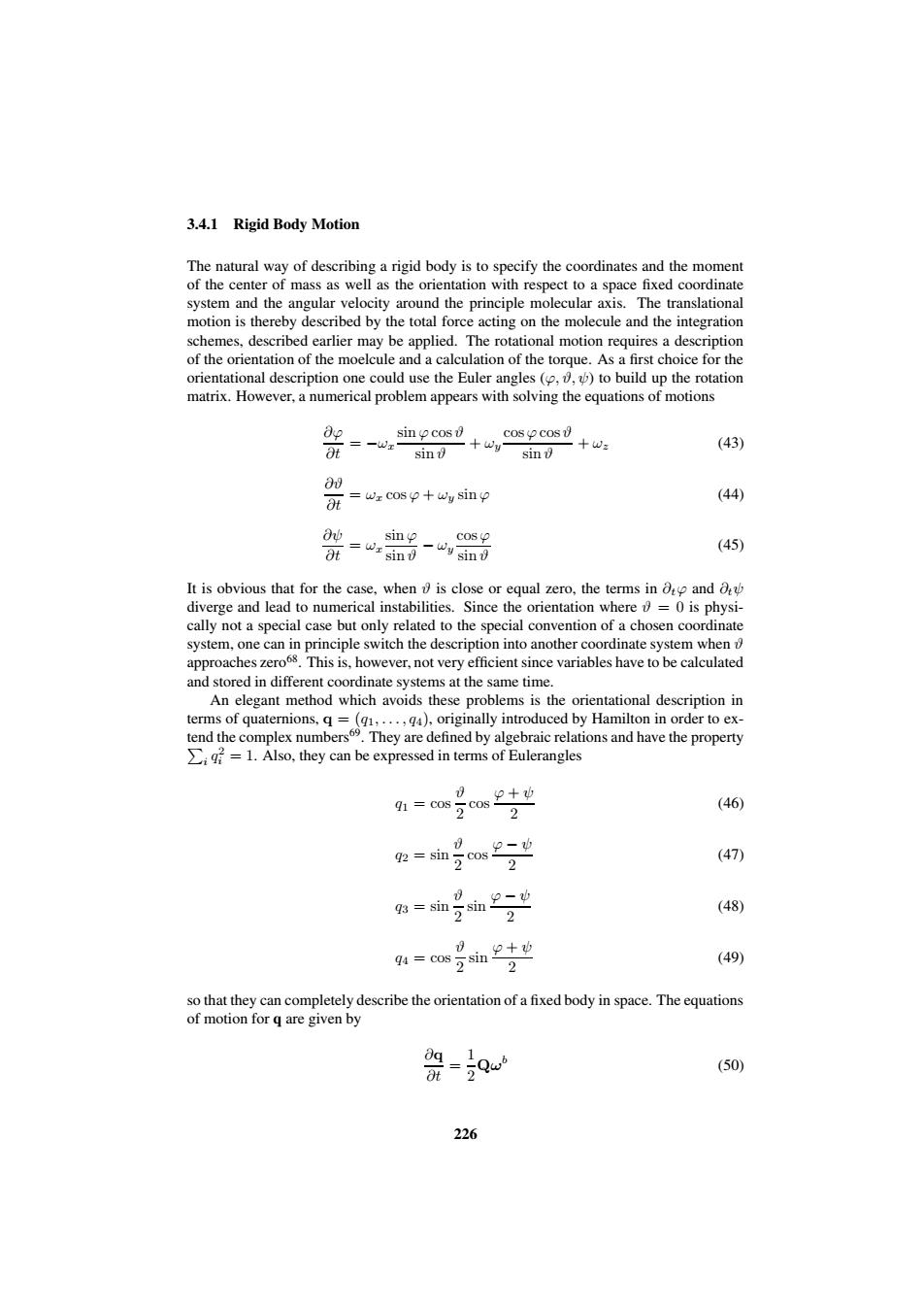正在加载图片...

3.4.1 Rigid Body Motion The natural way of describing a rigid body is to specify the coordinates and the moment of the center of mass as well as the orientation with respect to a space fixed coordinate system and the angular velocity around the principle molecular axis.The translational motion is thereby described by the total force acting on the molecule and the integration schemes,described earlier may be applied.The rotational motion requires a description of the orientation of the moelcule and a calculation of the torque.As a first choice for the orientational description one could use the Euler angles (to build up the rotation matrix.However,a numerical problem appears with solving the equations of motions bp sin o cos cos cos Ot 十wz (43) sin sin 80 =Wz cos o+wy sino (44) Ot Od sino cos -ws sin-vsin (45) Ot It is obvious that for the case,when is close or equal zero,the terms in dt and d diverge and lead to numerical instabilities.Since the orientation where=0 is physi- cally not a special case but only related to the special convention of a chosen coordinate system,one can in principle switch the description into another coordinate system when approaches zero8.This is,however,not very efficient since variables have to be calculated and stored in different coordinate systems at the same time. An elegant method which avoids these problems is the orientational description in terms of quaternions,q=(q1,...,q4).originally introduced by Hamilton in order to ex- tend the complex numbers9.They are defined by algebraic relations and have the property =1.Also,they can be expressed in terms of Eulerangles 41 cos (46) 2 9e=sin号cos2-业 0 (47) 2 9阳=sm7血2驰 0 (48) 2 9a=cos7sim2+驰 0 (49) 2 so that they can completely describe the orientation of a fixed body in space.The equations of motion for g are given by (50) Ot 2263.4.1 Rigid Body Motion The natural way of describing a rigid body is to specify the coordinates and the moment of the center of mass as well as the orientation with respect to a space fixed coordinate system and the angular velocity around the principle molecular axis. The translational motion is thereby described by the total force acting on the molecule and the integration schemes, described earlier may be applied. The rotational motion requires a description of the orientation of the moelcule and a calculation of the torque. As a first choice for the orientational description one could use the Euler angles (ϕ, ϑ, ψ) to build up the rotation matrix. However, a numerical problem appears with solving the equations of motions ∂ϕ ∂t = −ωx sin ϕ cos ϑ sin ϑ + ωy cosϕ cos ϑ sin ϑ + ωz (43) ∂ϑ ∂t = ωx cosϕ + ωy sin ϕ (44) ∂ψ ∂t = ωx sinϕ sin ϑ − ωy cosϕ sin ϑ (45) It is obvious that for the case, when ϑ is close or equal zero, the terms in ∂tϕ and ∂tψ diverge and lead to numerical instabilities. Since the orientation where ϑ = 0 is physically not a special case but only related to the special convention of a chosen coordinate system, one can in principle switch the description into another coordinate system when ϑ approaches zero68 . This is, however, not very efficient since variables have to be calculated and stored in different coordinate systems at the same time. An elegant method which avoids these problems is the orientational description in terms of quaternions, q = (q1, . . . , q4), originally introduced by Hamilton in order to extend the complex numbers69 P . They are defined by algebraic relations and have the property i q 2 i = 1. Also, they can be expressed in terms of Eulerangles q1 = cos ϑ 2 cos ϕ + ψ 2 (46) q2 = sin ϑ 2 cos ϕ − ψ 2 (47) q3 = sin ϑ 2 sin ϕ − ψ 2 (48) q4 = cos ϑ 2 sin ϕ + ψ 2 (49) so that they can completely describe the orientation of a fixed body in space. The equations of motion for q are given by ∂q ∂t = 1 2 Qω b (50) 226